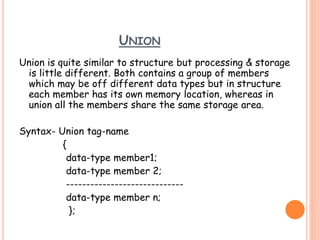Programming in C session 3
- 3. STRUCTURE Structure is user define data type. When we defined a structure as a group of elements of different data-type held together in a single unit .The individual elements are called data members of Structure. Members of the structure can be accessed & processed separately. The graphical representation of a structure is : Structure name Member-1 Member-2 Member-3 Member-n
- 4. Syntax : struct name { data-type member-1; data-type member-2; data-type member-3; ----------------------------- ----------------------------- data-type member-n; }
- 5. ACCESSING MEMBERS OF STRUCTURE The members of a structure variable are accessed using dot operator(.). The syntax is structure-variable. member name Example: struct date { int dd; int mm; int yy; } dob; The values to members of structure variable dob are assigned as: dob.dd=05; dob.mm=07; dob.yy=2014;
- 6. INITIALIZATION OF STRUCTURES Like variables of other data types, a structure variable can be initialized. For illustration consider the following segment. struct std { int rollno; char name[25]; char Dept[25]; }; struct std student={44,”Divesh”,”IT”};
- 7. FUNCTIONS & STRUCTURES In C ,structure can be passed to a function as a single variable. The scope of a structure declaration should be an external storage class whenever a function in the main program is using a structure data type. The member data should be same throughout the program. Individual structure members can be passed to a function as arguments in the function call & a single structure member can be returned through the return statement.
- 8. POINTER & STRUCTURE Through the use of (&) address operator, starting address of a structure can be accessed in the same manner as any other address. Therefore, if variable represents a structure type variable the & variable represents the beginning address of that variable. A pointer variable for a structure declare as : type *ptr to assign the starting address of a structure variable to pointer as ptr=&variable
- 9. Example: struct { int acc_no; char acc_type; char customer[50]; float bal_amount; } s_customer,*ptr_cust; Pointer structure can be accessed & processed in following way: (*structure_name).field name_variable;
- 10. ARRAY OF STRUCTURES When we want to process a list of values of structure type, it is required to use an array of structures. The array of structures are defined as simple structures, only the difference is that instead of a simple variable, we specify array variable name for structure.
- 11. Example: struct stud { int rollno; char name[25]; char dept[25]; int height; }; struct stud student[100];
- 12. NESTED STRUCTURES A structure can be embedded in another structure. The concept of nested structure illustrated by following example: struct name { char fname[20]; char mname[20]; }; struct sal { char empno[5]; char dept[15]; float salary; } employee;
- 13. UNION Union is quite similar to structure but processing & storage is little different. Both contains a group of members which may be off different data types but in structure each member has its own memory location, whereas in union all the members share the same storage area. Syntax- Union tag-name { data-type member1; data-type member 2; ----------------------------- data-type member n; };
- 14. DIFFERENCE Structure Union Structure allocates storage space for all its members separately. Union allocates one common storage space for all its members. Union finds that which of its member needs high storage space over other members and allocates that much space Structure occupies higher memory space. Union occupies lower memory space over structure. We can access all members of structure at a time. We can access only one member of union at a time. All members may be initialized. Only first member may be initialized. Consume more space than union. Conservation of memory is possible. Syntax: struct name { data-type member-1; data-type member-2; ---------------------- data-type member-n; } Syntax: Union tag-name { data-type member1; data-type member 2; ------------------------- data-type member n; }
Editor's Notes
- #2: By prerna sharma






![INITIALIZATION OF STRUCTURES
Like variables of other data types, a structure
variable can be initialized. For illustration consider
the following segment.
struct std
{
int rollno;
char name[25];
char Dept[25];
};
struct std student={44,”Divesh”,”IT”};](https://image.slidesharecdn.com/ppt3-140928235740-phpapp01/85/Programming-in-C-session-3-6-320.jpg)


![Example:
struct
{
int acc_no;
char acc_type;
char customer[50];
float bal_amount;
}
s_customer,*ptr_cust;
Pointer structure can be accessed & processed in
following way:
(*structure_name).field name_variable;](https://image.slidesharecdn.com/ppt3-140928235740-phpapp01/85/Programming-in-C-session-3-9-320.jpg)

![Example:
struct stud
{
int rollno;
char name[25];
char dept[25];
int height;
};
struct stud student[100];](https://image.slidesharecdn.com/ppt3-140928235740-phpapp01/85/Programming-in-C-session-3-11-320.jpg)
![NESTED STRUCTURES
A structure can be embedded in another structure. The concept
of nested structure illustrated by following example:
struct name
{
char fname[20];
char mname[20];
};
struct sal
{
char empno[5];
char dept[15];
float salary;
}
employee;](https://image.slidesharecdn.com/ppt3-140928235740-phpapp01/85/Programming-in-C-session-3-12-320.jpg)

